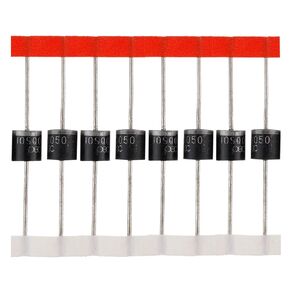- Shopping, made easy.
- /
- Get the app!
Anti-reverse(One Way) diodes, also known as Zener diodes, are a special type of diode used in voltage stabilization and voltage regulation applications. Its special feature is that it can maintain a stable voltage under a specific reverse voltage. The voltage stabilization characteristics of the anti-reverse diode are realized by its special structure and material composition. Under forward voltage, anti-reverse diodes behave similarly to ordinary diodes, with on and off characteristics. Under reverse voltage, when the voltage exceeds the rated voltage of the anti-reverse diode (called blocking voltage or Zener voltage), the anti-reverse diode will start to conduct and maintain a stable voltage at this voltage. This voltage stabilizing feature allows anti-reverse diodes to be used as voltage regulators or voltage reference sources. Anti-reverse diodes have a wide range of applications, common applications include: Voltage regulator: The anti-reverse diode can be used as a voltage regulator to provide a stable voltage output. It can stabilize the input voltage at a specific blocking voltage value, which is used to protect other circuit components from excessively high or low voltage. Voltage reference source: Since the anti-reverse diode can provide a stable voltage output, it is often used as a reference source in the circuit. For example, in an analog circuit, an anti-reverse diode can be used as a reference voltage source or a comparison voltage source. Overvoltage Protection: Anti-reverse diodes can also be used in overvoltage protection circuits. When the voltage in the circuit exceeds the blocking voltage, the anti-reverse diode turns on, bypassing the excess voltage around critical components to protect them from damage.

 ubld.it™ TrueRNG V3 - USB Hardware Random Number Generator
KWD 32
ubld.it™ TrueRNG V3 - USB Hardware Random Number Generator
KWD 32
 BOJACK 10SQ050 Schottky diode 10 A 50 V axial 10SQ050 10 amps 50 Volts for Solar Panel Parallel reflow Protection diodes (Pack of 20 pcs)
KWD 3.500
BOJACK 10SQ050 Schottky diode 10 A 50 V axial 10SQ050 10 amps 50 Volts for Solar Panel Parallel reflow Protection diodes (Pack of 20 pcs)
KWD 3.500
 20PCS 2SA1015GR 2SA1015 PNP Transistor TO-92 50V 150MA 400mW Marking A1015
KWD 2.500
20PCS 2SA1015GR 2SA1015 PNP Transistor TO-92 50V 150MA 400mW Marking A1015
KWD 2.500
 Bridgold 10pcs FQP30N06L FQP30N06 30N06 30N06L N-Channel MOSFET Transistor 32 A/60 V,3-Pin TO-220
KWD 4
Bridgold 10pcs FQP30N06L FQP30N06 30N06 30N06L N-Channel MOSFET Transistor 32 A/60 V,3-Pin TO-220
KWD 4